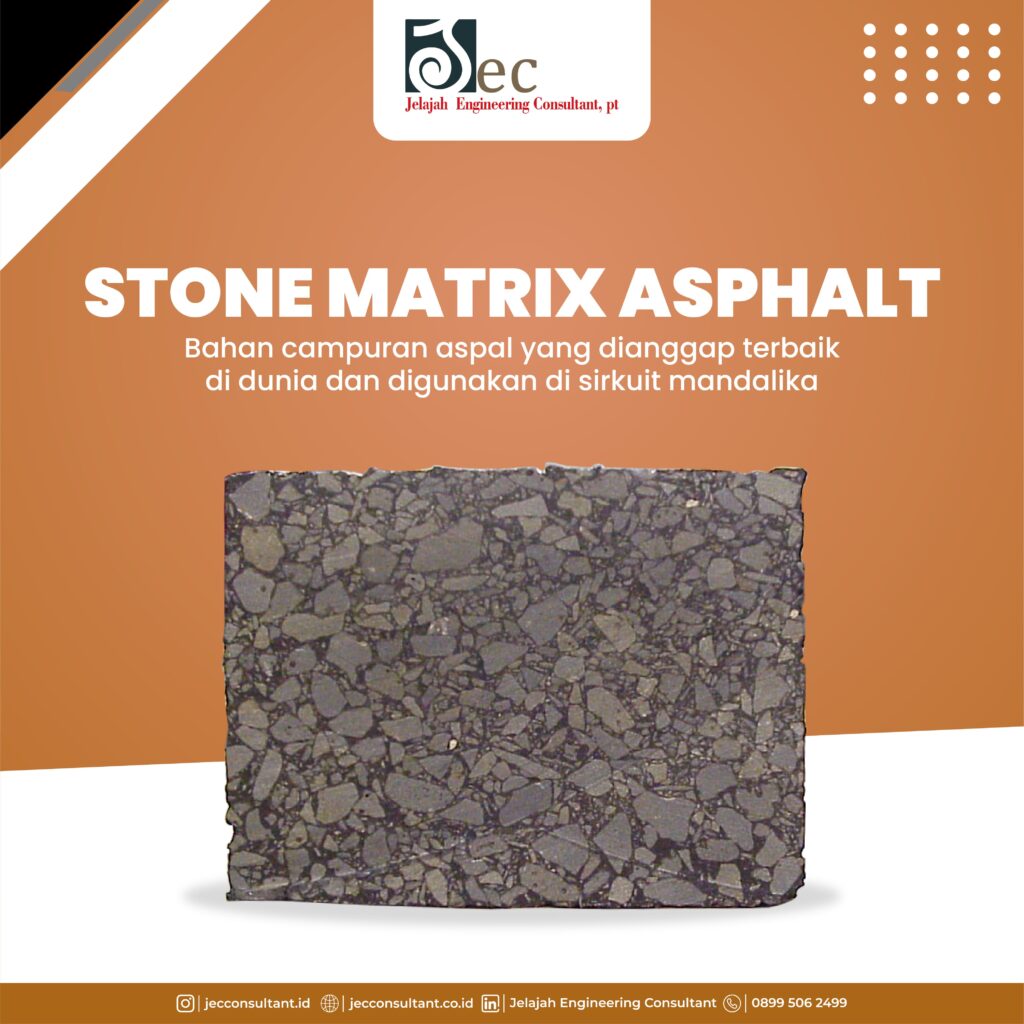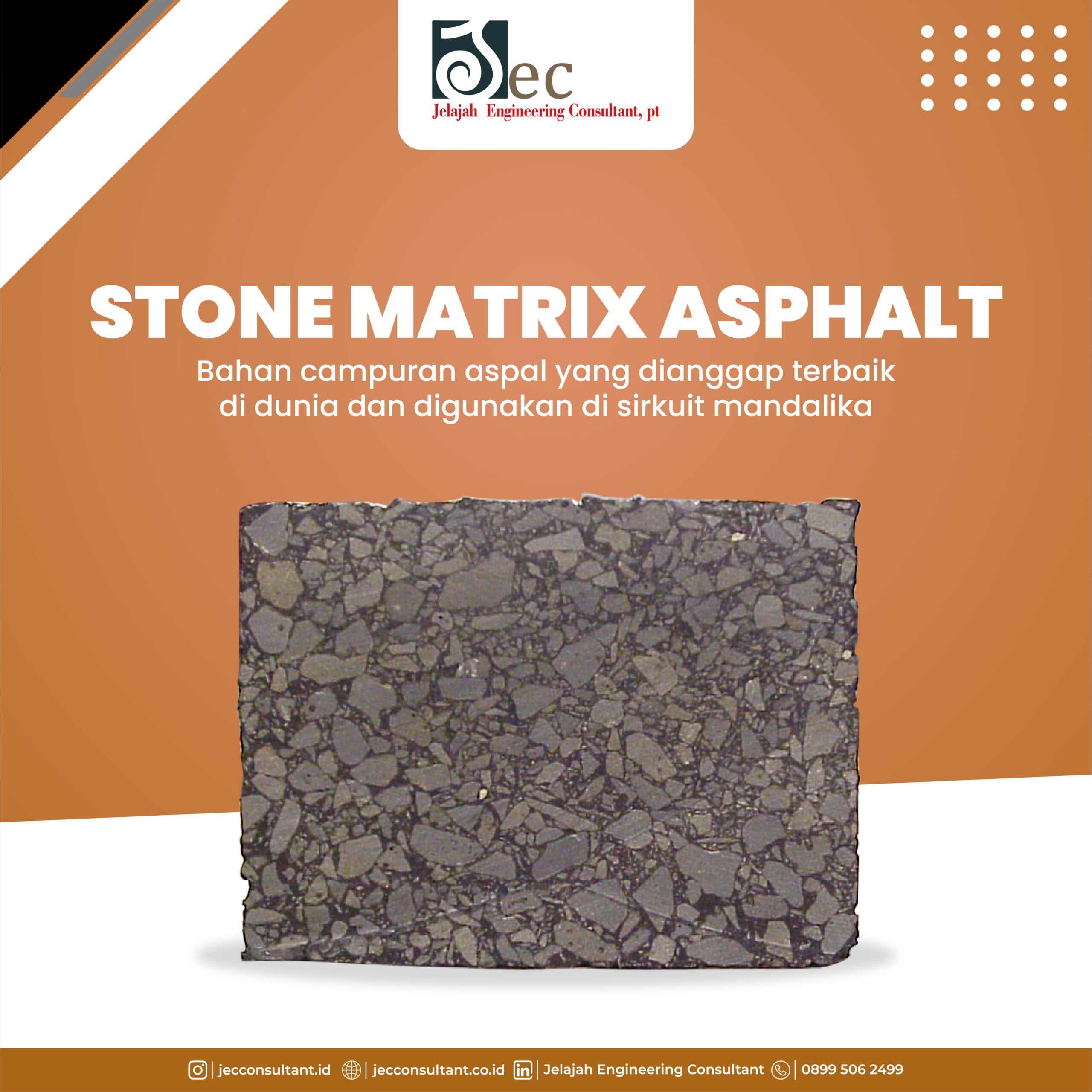
Sirkuit Internasional Mandalika di Pulau Lombok, Nusa Tenggara Barat (NTB) tidak hanya menawarkan panorama perbukitan dan laut yang indah, tetapi juga lintasan sirkuit yang menggunakan teknologi aspal terbaru yang diklaim terbaik di dunia.
Lintasan utama Sirkuit Internasional Mandalika diketahui menggunakan teknologi stone mastic asphalt (SMA). Teknologi ini dilakukan dengan metode perekatkan batu, dimana aspal tidak terlalu banyak digunakan karena hanya mengandalkan batu dengan batu.
Merupakan salah satu jenis campuran beraspal panas yang dapat digunakan sebagai lapis permukaan. Campuran SMA terdiri dari agregat bergradasi kasar yang relatif seragam dengan bahan tambah serat selulosa dengan proporsi sebanyak 0,3% terhadap berat total campuran. Teknologi ini memiliki keunggulan tahan gelincir (skid resistant) yang cukup tinggi dan tahan terhadap temperatur tinggi dan beban berat kendaraan sehingga cocok digunakan pada daerah iklim tropis
SMA memiliki daya penetrasi yang tinggi hingga 82, dengan daya penetrasi yang tinggi sehingga pembalap tidak mudah terjatuh saat terjadi wet race atau jalan licin akibat air hujan. Dengan menggunakan teknologi aspal terbaru, Sirkuit Mandalika bisa dibilang merupakan sirkuit yang memiliki teknologi paling maju dibanding dengan sirkuit-sirkuit Grade A internasional lainnya.
Bahan pembentuk lapisan SMA diambil dari beberapa daerah di Indonesia. Misalnya agregat kasar yang berasal dari Palu, Sulawesi Tengah, serta agregat halus yang berasal dari Lombok Timur dan Limestone filler yang berasal dari Jawa Timur. Semua material tersebut sudah dipilih dengan mempertimbangkan standar yang telah ditentukan untuk pembangunan sirkuit berstandar internasional.
Sumber :
https://www.indozone.id/sport/Z8sPmad/mengenal-stone-mastic-asphalt-teknologi-aspal-terbaik-dunia-di-sirkuit-mandalika/read-all
http://elearning.litbang.pu.go.id/teknologi/stone-matrixmastic-asphalt-sma
https://oto.detik.com/otosport/d-5606490/sirkuit-mandalika-pakai-aspal-sma-apa-itu


Guidelines for aluminum scrap collection Aluminum industrial scrap Recycling aluminum wires and cables
Aluminium scrap recasting Aluminium scrap streaming Scrap aluminium repurposed materials
Copper scrap buying Copper rod recycling Copper scrap traders
Copper scrap environmental impact Industrial copper dismantling Copper scrap import requirements
Aluminium recycling waste optimization Aluminium scrap reusability Aluminium recycling processes
Metal waste reclaiming center Ferrous material foundry Iron waste reclamation and recycling
Ferrous material handling, Recycled iron products, Scrap metal price fluctuations
Aluminium scrap upcycling Aluminum scrap sources Aluminium profile recycling
Metal scrap recovery Ferrous waste recycling center Iron scrap brokerage and trading
Ferrous material scrap appraisal, Iron waste recovery plant, Scrap metal reuse services
Metal scrap refurbishing services Aluminum scrap treatment Aluminum scrap repurposing
Metal waste recycling solutions, Aluminum cable scrap industry, Scrap metal recovery and reprocessing
Efficient metal waste handling Scrap aluminium inspection Aluminium salvage yard
Metal recovery solutions center, Scrap aluminum cable prices, Metal waste disposal services
Scrap metal marketing Aluminium scrap profitability Aluminium recycling evaluation
Metal reclamation and recycling yard, Aluminum cable recycling equipment, Metal scrap sourcing
Electronic waste recycling Ferrous material processing unit Iron waste collection points
Ferrous material recycling licenses, Iron recycle yard services, Scrap metal testing
Metal recycling operations Aluminum extrusion scrap Aluminium recycling economics
Scrap metal rejuvenation, Aluminum cable waste management, Metal scrap recycling center
Scrap metal supply chain Ferrous scrap reclamation facility Iron processing
Ferrous material recycling depot, Iron waste reprocessing plant, Scrap metal shearing
Metal reclamation facility services Aluminium scrap export-import trends Aluminium recycling industry benchmarks
Scrap metal recapturing and recycling, Sell aluminum cable for scrap, Metal reprocessing solutions
Metal waste analysis Ferrous material recycling client satisfaction Iron scrap handling equipment
Ferrous material industry trends, Iron scrap brokerage and trading, Scrap metal storage
Scrap metal industry Eco-friendly aluminium recycling Aluminium scrap trading
Metal recycling and reclaiming, Aluminum cable scrap grades, Scrap metal transport
Environmental metal recycling practices Ferrous metal sorting Iron scrap buyback
Ferrous metal recycling depot, Scrap iron processing center, Metal scraps reclamation
Metal waste utilization and trading Ferrous scrap waste management Iron scrap waste management
Ferrous material social responsibility, Iron scrap brokerage and trading, Scrap metal disposal services
Scrap metal processing center Aluminum scrap recycling process Aluminium scrap classification
Scrap metal market competition, Aluminum cable specifications, Scrap metal reclamation management
Scrap metal reprocessing plant Ferrous material appraisal Iron scrap reclaiming facilities
Ferrous material audits, Iron scrap management, Metal scrap reclamation yard
Scrap Copper export Exporting Copper scrap Copper scrap inspection
Metal waste reclamation and reuse, Copper scrap crushing, Scrap metal services
Copper wire recycling Copper wire is an excellent conductor of electricity and can carry a high current load without melting or breaking. However, this makes it unsuitable for use as a fuse wire for several reasons. Firstly, for a fuse wire to work correctly, it needs to have a relatively low melting point. This way, when a sudden surge of current flows through it, the wire can heat up and melt quickly, breaking the circuit and preventing damage to other components. Copper, however, has a relatively high melting point. This means that it would take a much longer time for it to heat up and melt, making it ineffective as a fuse wire. Secondly, copper wire does not have a consistent resistance, which is another crucial property required for a fuse wire to function correctly. When electricity flows through a wire, the electrical resistance in the wire produces heat. This heat is what causes the fuse wire to melt and break the circuit. If the wire’s resistance is too low, it may not produce enough heat to melt. Conversely, if the resistance is too high, it may melt too quickly, even if there is no surge in current. Copper wire’s resistance can vary significantly, making it unreliable as a fuse wire. Finally, copper wire is not designed to fail safely. When a fuse wire melts, it should break the circuit, preventing any further damage to other components. A copper wire, on the other hand, would continue to conduct electricity even after it had melted, posing a significant risk of fire or electric shock. In conclusion, while copper wire is an excellent conductor of electricity, it is not suitable for use as a fuse wire due to its high melting point, inconsistent resistance, and lack of safe failure mechanisms. Instead, fuses are typically made from metals like silver, tin, or copper alloys like brass, which have a low melting point, consistent resistance, and designed to fail safely Bronze scrap recycling Copper scrap industry publications Sustainable copper processing Copper alloy analysis Copper scrap purity standards Scrap metal exports
Copper scrap industry standards Copper has been mined and used by humans for over 10,000 years. Its ability to conduct electricity and heat as well as its malleability and resistance to corrosion have made it a valuable commodity in various industries. The earliest known use of copper can be traced back to ancient civilizations in the Middle East, including Egypt and Mesopotamia, where it was used to make weapons, tools, and decorative objects. The production of copper was eventually refined, and ancient miners discovered that the smelting process could increase the amount of copper extracted from ore. In the 1800s, the Industrial Revolution increased demand for copper, and large-scale mining operations began in the United States, Chile, and other countries. The invention of the steam engine made it possible to pump water out of deep mines, allowing miners to access deeper and richer ore deposits. Copper mining techniques continued to evolve with the advent of new technologies. In the 20th century, advancements in drilling, blasting, and the use of heavy machinery enabled mining on a much larger scale. The introduction of flotation processes to separate copper from other minerals, as well as the development of automated equipment, have made copper mining more efficient and cost-effective. Today, copper is still a vital component of modern infrastructure and technology. It is widely used in construction, electrical wiring, plumbing, and telecommunications. It is also an important component in renewable energy systems such as wind turbines and solar panels. Despite its long history, copper mining continues to face challenges. Environmental concerns related to mining practices, such as water pollution and ecosystem destruction, have led to increased regulation and scrutiny. The fluctuating price of copper, affected by global economic trends and supply and demand, has also impacted the industry. Nonetheless, copper remains a critical resource, and advances in mining technology are allowing miners to extract copper with greater efficiency and sustainability Metal reclamation and recovery Industrial copper salvage Copper scrap sourcing network Copper scrap purification Copper scrap pickup Scrap metal utilization centers
Metal repurposing facility Metal waste repurposing Iron waste recycling solutions
Ferrous material by-product marketing, Iron recyclers, Metal recycling and reclamation facility
Copper scrap insurance Copper carbonate scrap acquisition Scrap metal recycling technologies
Value of scrap Copper cables, Scrap metal reclamation and reuse, Commercial copper scrap buyer
Environmental impact of metal recycling, Scrap copper warehousing, Copper cable scrap refining, Scrap metal sales
Scrap metal procurement Ferrous material regulatory standards Iron waste reprocessing
Ferrous scrap reclaiming solutions, Iron and steel scrapping yard, Metal scraps reclamation yard
Metal reclamation and repurposing Ferrous material compliance Iron reclaiming and recycling
Ferrous material recovery and processing, Scrap iron disposal, Scrap metal disposal services
Scrap metal reclamation and utilization services Ferrous material recycling collaboration Iron salvage and recycling
Ferrous material recycling awareness, Iron waste reclaiming center, Metal disassembling
Metal retrieval Ferrous waste regulatory standards Iron reprocessing services
Ferrous material recycling expos, Iron recovery and reclamation, Scrap metal inspection services
Metal recycling consultancy Ferrous waste minimization Iron scrap reusing
Ferrous material sorting machinery, Iron reprocessing and repurposing, Scrap metal sustainability standards
Jak odzyskać usunięte SMS – Y z telefonu komórkowego? Nie ma kosza na SMS – Y, więc jak przywrócić SMS – Y po ich usunięciu?
Oprogramowanie do monitorowania telefonów komórkowych CellSpy jest bardzo bezpiecznym i kompletnym narzędziem, najlepszym wyborem do efektywnego monitorowania telefonów komórkowych. Aplikacja może monitorować różne typy wiadomości, takie jak SMS, e-mail i aplikacje do czatu, takie jak Snapchat, Facebook, Viber i Skype. Możesz wyświetlić całą zawartość urządzenia docelowego: lokalizację GPS, zdjęcia, filmy i historię przeglądania, dane wejściowe z klawiatury itp.